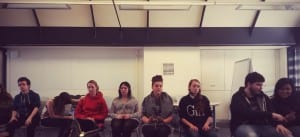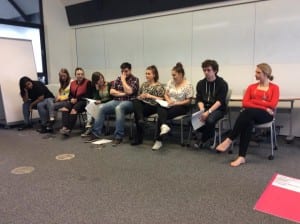Becoming a company
“Developing a [theater] company, on the other hand, needs capital, vision, teamwork, passion, organization, tenacity, solid management, and more than a little look” (Nelson, Schwimmer 2010). As Reginald Nelson, David Schwimmer has stated each individual has to bring hard work and determination to the company. However, it is to do with how everyone works as a whole. Over these past these weeks, we’ve been allowing ourselves to develop as a theatre company. As we are a group of 11 with a variety of personality we are all keen to share our ideas and with that we have a lot of ideas.
The main focus was obviously to do with what sort of performance we wanted to produce. Often things to do with technology got brought up and we looked into YouTube videos, such as https://www.youtube.com/watch?v=Z7dLU6fk9QY (Turk, 2014). We would often discuss what we could to do create originality. Furthermore, we would go off onto tangents, which was helpful and led us to our finally ideas.
With endless discussion, we realised that our ideas often left us with things we can relate and what our parents relate to. Overall, we often discussed how our university experience is coming to an end; we raised the subject of ‘what do we do next and how we wanted to make our parents proud’. A meeting we had previously, we all kept referring to the term ‘remember when…’ we would deliberate about old times on when we were growing up as children. This brought us to our final idea. Adulthood!
From this we then discussed a title name for our show. With much debate and ideas, we had a vote and landed on the name ‘Shoes to Fill’. Now it is time to crack on, work hard and make a performance to remember.
Work cited
Nelson R. and Schwimmer, S. (2010) How to Start Your Own Theater Company. Chicago review press.
YouTube (2014) Look up. [Online advertisement] https://www.youtube.com/watch?v=Z7dLU6fk9QY [accessed 29rd March]
Putting our ideas together
Over the Easter holidays Tamsyn left us with direction to interview our relatives and friends so we can start to create our verbatim scenes. We asked question to do with growing up/what life has been like. I got the chance to interview my seven year old cousin, who acts quite grown up for her age. Interviewing her has brought some comedic affect to our show.
Since coming back from the Easter holidays, we have got a script to work from. It is still early days to who has which characters. It is engaging to read through script and to get a feeling of the characters that can be developed. However, we know they will be a lot of changing to the script so we just have to work with what we have so far. As we know, it will be a stop and start process with the writers editing the script throughout this procedure. The writers have been able to bring a variety of ages and diverse set of people to our script. This allows us actors to work on our character development. As there so many characters, we know that we will be more than one character throughout.
At times we had concerns with the script but our writers worked well on it, even up till performance week. The reason for this is when we came to rehearsing scene we all had ideas of how we could improve a scene. The writers were considerate and took on board our ideas. They went away and added our ideas into their own style of writing.
However, there are strong points to our script and the writers have worked incredibly hard to make sure we had a script after Easter. The two scenes I particularly like are the university poem and the tinder scene. I think these two scenes will go down well with the audience and bring life and laughter to the performance. Luckily, I got assigned a role to both scenes, which I was really excited about. We also realised we were one level through the scenes we had worked on so fair. we were constantly sat on seats. Even when we were not in a seat, we were at the back of the stage on seats.
Our script is very word based. In rehearsals, we struggled to add movement to scene that connected with what the words were saying. Before Easter we worked on chair duets and now we want to get rid of work we developed before Easter to suit the script. Often we found ourselves hitting barriers and struggling establish powerful scenes. At times it was hard for us all to agree on ideas but I felt that helped us to agree and adjust more to each other’s ideas.


(Photos by Tamsyn Webley, 2015)

(Photos by Emmie Kearns, 2015)
Work cited
Kearns, E. (2015) Rehearsal Process.
Webley, T. (2015) Rehearsal Process.


